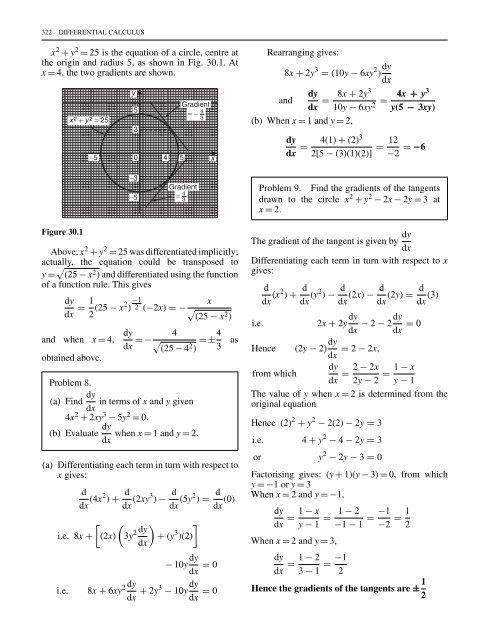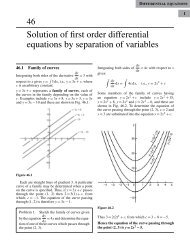differentiation
Create successful ePaper yourself
Turn your PDF publications into a flip-book with our unique Google optimized e-Paper software.
322 DIFFERENTIAL CALCULUS<br />
x 2 + y 2 = 25 is the equation of a circle, centre at<br />
the origin and radius 5, as shown in Fig. 30.1. At<br />
x = 4, the two gradients are shown.<br />
x 2 + y 2 = 25<br />
y<br />
5<br />
3<br />
Gradient<br />
= − 4 3<br />
−5 0 4 5 x<br />
Rearranging gives:<br />
8x + 2y 3 = (10y − 6xy 2 ) dy<br />
dx<br />
dy<br />
and<br />
dx =<br />
(b) When x = 1 and y = 2,<br />
8x + 2y3<br />
10y − 6xy 2 =<br />
4x + y3<br />
y(5 − 3xy)<br />
dy 4(1) + (2)3<br />
=<br />
dx 2[5 − (3)(1)(2)] = 12<br />
−2 = −6<br />
−3<br />
−5<br />
Gradient<br />
= 4 3<br />
Problem 9. Find the gradients of the tangents<br />
drawn to the circle x 2 + y 2 − 2x − 2y = 3 at<br />
x = 2.<br />
Figure 30.1<br />
Above, x 2 + y 2 = 25 was differentiated implicitly;<br />
actually, the equation could be transposed to<br />
y = √ (25 − x 2 ) and differentiated using the function<br />
of a function rule. This gives<br />
dy<br />
dx = 1 2 (25 − x2 ) −1<br />
x<br />
2 (−2x) =−√ (25 − x 2 )<br />
and when x = 4,<br />
obtained above.<br />
dy<br />
dx =− 4<br />
√<br />
(25 − 4 2 ) =±4 3<br />
Problem 8.<br />
(a) Find dy in terms of x and y given<br />
dx<br />
4x 2 + 2xy 3 − 5y 2 = 0.<br />
(b) Evaluate dy when x = 1 and y = 2.<br />
dx<br />
(a) Differentiating each term in turn with respect to<br />
x gives:<br />
d<br />
dx (4x2 ) + d dx (2xy3 ) − d dx (5y2 ) = d dx (0)<br />
[ (<br />
i.e. 8x + (2x) 3y 2 dy ) ]<br />
+ (y 3 )(2)<br />
dx<br />
− 10y dy<br />
dx = 0<br />
i.e. 8x + 6xy 2 dy<br />
dx + 2y3 − 10y dy<br />
dx = 0<br />
as<br />
The gradient of the tangent is given by dy<br />
dx<br />
Differentiating each term in turn with respect to x<br />
gives:<br />
d<br />
dx (x2 ) + d dx (y2 ) − d dx (2x) − d dx (2y) = d dx (3)<br />
i.e.<br />
2x + 2y dy<br />
dx − 2 − 2 dy<br />
dx = 0<br />
Hence (2y − 2) dy<br />
dx = 2 − 2x,<br />
dy<br />
from which<br />
dx = 2 − 2x<br />
2y − 2 = 1 − x<br />
y − 1<br />
The value of y when x = 2 is determined from the<br />
original equation<br />
Hence (2) 2 + y 2 − 2(2) − 2y = 3<br />
i.e. 4 + y 2 − 4 − 2y = 3<br />
or y 2 − 2y − 3 = 0<br />
Factorising gives: (y + 1)(y − 3) = 0, from which<br />
y =−1ory = 3<br />
When x = 2 and y =−1,<br />
dy<br />
dx = 1 − x<br />
y − 1 = 1 − 2<br />
−1 − 1 = −1<br />
−2 = 1 2<br />
When x = 2 and y = 3,<br />
dy<br />
dx = 1 − 2<br />
3 − 1 = −1<br />
2<br />
Hence the gradients of the tangents are ± 1 2










